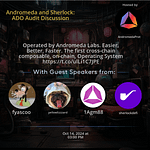Space Summary
The Twitter Space Berachain Speed-Dating #3: Vase & Booga Beras hosted by coinage_x_daic. Berachain Speed-Dating #3 focused on community validation across 40+ chains and 13 AVS on EigenLayer. It highlighted Alpha offerings and partnerships with @coinage_media & @daic_capital, emphasizing inclusivity, efficient networking, and DeFi applications within the Infrastructure niche. Discussions underscored the significance of diverse perspectives, collaborations with experts, and unique value propositions for users and developers in the Berachain ecosystem.
For more spaces, visit the Infrastructure page.
Questions
Q: Why is community validation crucial for Berachain?
A: Community validation ensures active engagement, fosters trust, and drives the project's growth.
Q: What are the benefits of integrating multiple chains and AVS on EigenLayer?
A: Integration enhances scalability, efficiency, and accessibility to various blockchain networks.
Q: How do Alpha offers contribute to the Berachain ecosystem?
A: Alpha offers provide users with exclusive opportunities to participate early in innovations and projects.
Q: What role do partnerships with @coinage_media & @daic_capital play in Berachain's development?
A: Partnerships bring additional expertise, exposure, and networking opportunities to Berachain.
Q: Why is inclusivity important in blockchain projects like Berachain?
A: Inclusivity ensures diverse perspectives, innovation, and broader community participation.
Q: How can collaborations with industry experts benefit blockchain initiatives?
A: Collaborations expand resources, knowledge, and market reach, contributing to project success.
Q: How does efficient networking advance blockchain interoperability within Berachain?
A: Efficient networking fosters partnerships, cross-chain solutions, and interoperability for seamless user experiences.
Q: What unique value propositions does Berachain offer for its users and developers?
A: Berachain provides unique tools, services, and opportunities to enhance user experiences and developer innovations.
Q: What are the implications of DeFi applications within the Berachain network?
A: DeFi applications offer decentralized financial services, lending, and investment opportunities within Berachain's ecosystem.
Highlights
Time: 00:15:42
Community Validation Strategies Discussing methods to validate community engagement and feedback within Berachain.
Time: 00:25:18
Integration of Multiple Chains on EigenLayer Exploring the benefits and challenges of incorporating various blockchain chains on EigenLayer for enhanced performance.
Time: 00:35:55
Alpha Opportunities and Early Access Detailing exclusive Alpha offers and their significance for early adopters in Berachain's ecosystem.
Time: 00:45:30
Partnerships with Industry Leaders Exploring the impact of collaborations with @coinage_media & @daic_capital on Berachain's roadmap and growth.
Time: 00:55:12
Inclusivity and Diversity in Blockchain Highlighting the importance of inclusivity and diversity in driving innovation and sustainability within Berachain.
Time: 01:05:44
Networking for Blockchain Interoperability Strategies for efficient networking to promote cross-chain solutions and interoperability within the Berachain network.
Time: 01:15:20
Unique Value Propositions in Berachain Ecosystem Exploring the distinctive features and benefits that Berachain offers to its users and developers.
Time: 01:25:37
DeFi Applications in Berachain Understanding the role of decentralized finance applications in providing financial services within the Berachain platform.
Key Takeaways
- Community validation and engagement are core aspects of Berachain's ethos.
- The space explored the integration of 40+ chains and 13 AVS on EigenLayer for increased efficiency.
- Insights were shared regarding Alpha opportunities within the Berachain ecosystem.
- Collaborations with @coinage_media & @daic_capital highlight external industry partnerships.
- The significance of inclusivity and community participation in blockchain technology projects.
- Berachain emphasizes the importance of diverse perspectives in developing a robust ecosystem.
- Partnerships with industry experts can amplify the reach and impact of blockchain initiatives.
- Efficient networking and collaborations are key elements in advancing blockchain interoperability.
- Exploring unique value propositions within the Berachain ecosystem for users and developers alike.
- Understanding the potential of decentralized finance (DeFi) applications within the Berachain network.
Behind the Mic
Introduction to the Session
Sadeena. All right, gmbaras, let's get started. Yeah, I can hear you. I'm here. Cool. I'm thrilled to have everyone here today for our third edition of our beta chain speed dating series where we are going to explore the most exciting projects built on the Bara chain. A special thanks to our guests, Nomad, for being part of our third space. Exciting to have you all. Have you with us. Yeah, thanks for having me, man. Always good to talk. To give you a short intro about coinage Xdike. My name is Marcus and I am with coinage Xdike and we are running a community validator across more than 40 mainnets, including one also on the Verachin testnet, and attracting stake from over 33k people to get things rolling. Can you share a bit about yourself and your team and how you got involved into this wild west called crypto?
Origins of the Team
Yeah, of course. So our team originally comes from Tradfi and web two, but we started getting into web three and the crypto space many years ago. So me personally, I previously worked at an investment fund. Full sectors including us, equities, some venture deals and real estate. And then at the later stages, we started getting into crypto a lot. So actually, this crypto focus is what made me get deeper into DeFi and the overall ecosystem. And there was an overlap when I was working in this investment fund and web three, but then kind of the risk parameters and all of that was kind of being restrictive for what I wanted to do in crypto, so started to go on my own, and then we formed this amazing team that I met across various different things. And right now we're working on base. So the rest of the team, they're all developers.
Transitioning to Web3 Projects
So they used to do a lot of web two infrastructure for the institutions and for the banking industry, and we all started getting into some web three projects for that. So, like, we ported some of the things they were doing. So defi hedge fund solution, web three payment systems for institutions and different stuff like that. And right now we currently operate multiple validators across several networks for institutions, some white label. And this is why we sort of started doing base, because it all came from a need that we, as validators, experienced, and we kind of want to close this gap in the market for something truly useful and that can be tailored for multiple ecosystems. Yeah, that's quite interesting. So you actually swapped to the good side of life to web three some years ago.
Bugabera and NFT Collection
That's quite impressive, man. So for those who are not familiar with the Bugabar because you are also have an NFT collection. And waze, could you give us a brief overview about it? Yeah, absolutely. So we're working on two projects in parallel. So vase finance is the main platform and defi protocol that we're working on. But then Bugaberas was kind of our approach at reaching out to the community, kind of establishing an early chain ecosystem. And it's a tool that's kind of going to serve as a demo of how protocol or brand should interact with base. So with bugaberas, we run different validators across chains, like Eigen layer, osmosis. Then we have some different apps, like something we're calling buga on liquidity, which is essentially a proof of liquidity proxy for protocols that don't have their assets whitelisted.
Dynamic NFTs and Their Utility
So, yeah, basically building a lot of different apps and value adds. And the NFTs are at the center of it all. So they essentially get a portion of all the rewards generated by what we do. And yeah, so that's how it ties into base. So let's start to talk first a little bit about the buga bearers. And on the second part, we shift the gears to waste finance. The bugabaras aren't typical nfts. They are so called dynamic nfts. Can you explain us a little bit what's the difference between dynamic NFTs and normal NFTs, which we are normally? No. Yeah, of course. So dynamic NFT is essentially an NFT that whose traits and metadata can be changed based on specific parameters. And after it's minted, you can still modify some stuff.
Customization and Traits of NFTs
So on the community side, it's possible to change the, it's going to be possible in Verich, in mainnet to change the traits of your NFT, to kind of build it to your own Persona, make it look like you want it to kind of represent you more in depth. But then another part of being able to change these traits comes with utility. So, for example, the bugabaras are also going to have utility and visual traits. So all of the utility traits help you kind of tailor how you want to approach the booger bears ecosystem. So, for example, a portion of rewards for the bugabaras comes from validators. So if you want to get access to more liquidity coming from these validators, then you get a utility boost. Boost your validator rewards.
User Engagement and Strategy
If you're more focused in governance and the long term growth of the collection, then you get a utility boost. You're able to customize everything on how you want to approach the brand and how you want to tailor your NFT to yourself. So that was why we decided to make these NFTs dynamic so you can kind of customize and keep the NFT alive for a longer period of, instead of being stuck with one solution that might not tailor to what you want in the future. So the bugaberas are not actually a normal NFT, a useless NFT collection, and I can call it that way. They are trying to bring value to the end, to the community which are holding the NFTs. Right. I'm not sure if we lost it.
Connection Issues and Continuation of Discussion
Still there. Not sure if I lost. Yeah, now we can hear you again, so I will try again to ping him. I'm not sure what's the problem currently because I think he should be speaker and also still is in the space. Sorry for the inconvenience. He will join shortly. So I think we have no mail on board again. Hey, sorry about that. I think I lost connection. Hello, Beckman. Sorry. Absolutely no problem. I think we got interrupted by the part about the use case from the Bugabarra NFTs. I mentioned that the Bugabaris are not a normal NFT. They are bringing value to the NFT holders, right?
Utility and Customization of Bugabera NFTs
Yeah, exactly. So the bugabaras is your kind of center of access for everything we're building under the Bugaberas brand. And then. Yeah, the dynamic NFT was kind of to be able to let users customize whatever they want for their NFT. So we have visual traits for looks and then utility traits for how you want rewards to come. So, for example, if you want more rewards from the validator side of what we're doing, then you get a utility booster for validator rewards. If you're concerned more about governance and the growth of the collection, then you can get a governance booster. So you're going to get more governance tokens and kind of, we're adding all of these utility boosters for users to be able to customize their strategy on how they want to engage with bugaberas.
Dynamic NFT Standard and Engagement
And this kind of works like a sort of defi protocol where users buy an asset and then they decide the strategy of how they want to interact. So that's why we decided to do the dynamic NFT standard. So it's actually all depending on the traits the NFT has, how much apr I get for the NFT? Yeah, exactly. So everything starts at a baseline. So all bugabaras are the same. But then as you grow into the collection and as there's new stuff being released, then you're going to be able to modify.
Accessing Trades and Seasonal Releases
So if you want to get more access to something, you just get a booster and you're following that route. Okay. So you are going to release the trades from time to time and not all at once. Yeah, exactly. So it's going to be seasonal. So you're going to be able to change the looks depending on what we're doing right now and the utility based on that. So it's a way to keep excitement on the collection as well, long term, not being stuck to an initial generation, but you can actually customize it through time.
Selling Trades and Their Relation to NFTs
So. And can I also sold the trades, for example, on a market or something like that? Or are they bond to the NFT? It's going to be bonded to the NFT. So whatever you apply to it's going to be reflected in different marketplaces. So you're essentially accruing value on the NFT. And then if you ever want to sell it actually goes with everything that's inside it. Okay. And the trades are limited or are they actually for all bugaberas? So there's going to be different levels of trades. I guess some are going to be accessible to everyone, and then some are going to be time limited or as a reward for a specific event and different activities that we're going to do for the collection.
Introduction to Waze and Its Core Idea
Yeah, it's quite cool. So let's shift the gears a little bit and let's talk a little bit about waze. Can you explain what Waze is and the core idea behind it? And was there an initial trigger where you decided to build this platform? Yep. So Waze is a liquid risk taking protocol, and we leverage proof of liquidity to kind of enable Pl restaking for any staking asset. What this means is that using the proof of liquidity architecture, we can allow users to bring any staking assets, such as Ethereum, Solana, Celestia, into verichain as an LST through base.
How Waze Operates and Its Advantages
And then we provide the infrastructure for you to restake and access more yields and have all of this utility be more productive. So all of this happens natively in Vera chain through re hypothecation. And then the main motivator for this was we kind of saw the space of different liquid staking protocols, liquid restaking and all of these. And they're usually limited to one ecosystem or to one use case. And once we saw Verachain and how it was handling the liquidity versus security problem through proof of liquidity, we saw this as a perfect opportunity to kind of create a central hub where all assets can be productive and fall under the same infrastructure for providing both liquidity and security.
Technical Overview of Waze Functionality
So it's like an aggregator which is funneling all the assets from the different chains into one platform and give access to all. Exactly. So it's a much more compelling solution than existing protocols that usually focus on a single ecosystem. Okay, can you give us a brief overview about the technical level? On a very high level, how all this, how the main process is? Yeah, of course. So base finance lives inside of parachain as the main contracts are there. And then these contracts connect via multiple bridges and communication protocols. To stake involves in the different target ecosystems. So essentially as a user, you come to the base finance platform.
User Experience and Staking Process
Then we see if you have token, if you have ETH on the ETH network. If you do, then we take that ETH, stake it in the vault in Ethereum, and then we issue the lsts on the bear chain side. If you already have staking assets on Verichain, then we take those assets for you. We bridge them to the native chain and we stake them in that vault. So all staking will happen externally from Vera chain and all LST issuance will happen inside of Vera chain. This is done to prevent liquidity fragmentation and to kind of have a cohesive incentive system inside of parachain, leveraging BGT emissions.
Broadening Ecosystem Access via Waze
And you are using solutions like Shogun or layer zero to have access to all these different chains and messaging providers. Yeah, exactly. So one of the things some protocols do is they do app chains or like a full app chain. Yeah, it's useful up to some degree. But for us, being just contracts and different staking vaults gives us the flexibility to kind of onboard any asset. So the architecture itself allows us to tap into any ecosystem that we want. And yeah, use things like layer zero union or even shogun for bridging without bridging.
Advantages of Waze's Architecture
And yeah, kind of access all of this liquidity and bring it into bear chain. That's quite cool. We already had Brandon from Shogun on our first with the space to kicking off this series. And it's quite impressive what the guys are building. And it's a little bit steels because not much info is currently right now out about what they are building. So curious what they are doing. So there's another question that can you. There's a distinction between traditional restaking and proof of liquidity restaking always.
Difference Between Traditional and Liquidity Restaking
Can you clarify the difference perhaps with example or something like that? For example, using Eigen layer as a restaking platform and using waze as a restaking platform, because it's not really similar. Yeah, so there's a few differences. So the core concept stays the same in terms of results. But when you interact with Eigen layer, for example, you bring your liquid staked ETH assets, deposit them there, where Eigen layer essentially creates pool security that it then rents out to different protocols or data layers or anything that wants to tap into that.
Ecosystem Focus with Eigen Layer
So this focuses on a single asset or single ecosystem, and then you're essentially only providing security to these different protocols. And the yield is going to come from whatever these protocols decide to pay, whether it is in different incentives or their native tokens. When it comes to pol restaking, Vera chain itself is acting as the AV's. So base finance. First you can bring any unstaked asset, and then we issue an LST. Then we have this entire incentive structure where we're focusing BGT emissions to the liquidity pools of our assets.
Transformation of Liquidity into Security
So then you take this LST and restake it into these pools, and then all of this liquidity is essentially converted into security by Vera chain. So whenever you're providing liquidity to any pool, Vera chain takes this and issues BGT emissions. So all of the liquidity that, based on boards, is accessible to anyone interacting through the chain. So you're gonna get restate, Solana, restake, ethereum, restate, celestia and everything on tap for any protocol or chain l two building on top of veriching.
Accessibility and Efficiency of Restaking
So yeah, essentially achieving the same result, but with a much broader asset base, as we can tap into any ecosystem, and veriching serves as the conversion from liquidity to security. So the restaking actually happens when you are depositing the LST in a certain LP on the bix, for example. Right? Yeah. So we're actually going to focus on, our LP's on the Kodiak Dex, mainly because they have this automated liquidity management, which takes advantage of concentrated liquidity.
Strategic Liquidity Management
So with this, instead of providing, like, we're going to set up the Sweden islands, which are like pretty fine strategies for users to deposit into, which is going to help them counter impermanent loss and be more efficient with their liquidity. So, for example, for an asset like Ethereum, you're ideally not want to provide liquidity at the full range, because most of that's going to be wasted. So a concentrated liquidity position essentially allows you to provide liquidity pinpointed at a price range closer to what it's actually trading.
Efficiency in Liquidity Provision
So all liquidity is efficient. So that's the way we're going to do it. All of base emissions are going to be targeted towards these liquidity pools in codec and different dexs according to strategies. And we also have a full incentive network of validators and different stakeholders that are going to push bgt emissions native from vera chain into these same pools. So for the user it's pretty simple. It's just a click of a button and everything's done for them.
Stakeholder Network and Benefits
They simply collect the additional yield. You already mentioned the stakeholders. I can imagine by such a complex architecture you have a lot of different stakeholders. Can you give us a brief overview about the stakeholders and the advantages they have? Yeah, absolutely. So this we haven't covered in depth since went out of stealth, but yeah, one of the core things we wanted was to kind of remove all the downsides of a liquid stake token. So in many designs, in other protocols, you lose a lot of the utility of the token when you liquid stake.
Voting and Validator Flexibility
So for example, you're not going to be able to vote, you can't choose which validator you want to stake to and different things. So with faze, we try to keep the experience as close to a traditional stake token. So for example, stakers are going to have the greatest flexibility. They can still choose which validator they want to stake with. They can vote, it's going to be a vote by proxy. So they essentially cast the vote on base and then we cast it for them on chain and then they retain everything. So for stakers, it's basically as much flexibility as possible and as close of an experience to a normal stake token. Then for validators, we also have different solutions, like bribing gauges, similar to what proof of liquidity does, and then even a governance marketplace.
Validator Incentives
So as a validator, if you want to attract more delegations to your set, instead of simply offering the same base APR that everyone can offer, you can actually bribe a gauge type to your validator where you're boosting the rewards for stakers. So let's say traditional celestial validators, giving 10% APR, you can apply a bribe to your gauge and you're giving 11% APR to your delegators, you're kind of differentiating your validator from the others and attracting more liquidity through that. Then there's also a different application of these bribing gauges since they're going to be kind of assigned to every validator on every chain. The chains themselves can use this as a decentralization agent.
Promoting Decentralization
So instead of doing foundation delegations to spread the stake across different validators, which is very capital intensive and dilutes the APR for everyone. They can use bribes to target additional delegations to validators in the lower set. So that's going to have an effect of decentralization in the net. It's going to help the small guys and can prevent you from actually diluting APR too much. So it's a much more capital efficient solution. And, yeah, those are some of the things. But, yeah, we're trying to keep these lsts full of utility.
Validation and APR Dynamics
That's quite cool, man. Yeah. I really like the idea how you are going to approach the approach, how you are trying to make more APR for the specific validators on the specific chain. That's quite impressive. And it's also quite unique, in my opinion. Yeah. So, honestly, for these things, you have to stand out. Like, the ultimate goal is going to be to provide utility for everyone. There's certain protocols that target one or two users in the whole chain, but for us, it's important to kind of target everyone following that same thesis of proof of liquidity, where you have every single actor aligned to in terms of incentive, security and all of that.
Understanding Gaussians
So kind of bringing this pol. Thesis to proof of stake chains. Yeah, because the most chains, the most protocols, I would say, are not really, they are considering a lot of the stakeholders, but for sure. And not the validators, to be honest. Yeah, so that's the thing. Exactly. So we're actually excited of how proof of liquidity works. So we're kind of, once validators get to experience that sort of customization and utility, then they're going to be more familiar with Bayes, and they're going to be able to experiment in different ways than before.
Gaussians Explained
Yeah, I want to go a little bit more in detail about the Gaussians. We have. It's actually a normal term in the Bera ecosystem because you also have the Gaussians to bootstrap the liquidity pools. But the Gaussians are actually a little bit different on waze. Can you explain that a little bit and how they influence the APR that validate can offer? Yeah, absolutely. So in most POS chains, you have a list of validators, right. What base is doing is assigning one vault, which is the gauge to each of these validators.
Capital Injection and NFT Impact
So what can happen is anybody, including the validator, the chain, or a user or a protocol, can deposit into this vault. So essentially, for you guys, if you have a gauge assigned to coinage, you can deposit some tokens there. And then what the base platform is going to do is reflect all of those bribes as additional APR for when I'm staking to you. So if you deposit a lot of assets into that, then everyone who's staking through vase into your validator is going to essentially get a portion of the rewards held in this vault, which essentially gives them a greater APR.
Strategies for Newly Started Validators
So there's multiple things you can do with that. So if you're a validator just starting, then you can get a capital injection to kind of provide more rewards there. And then you're going to be more appealing to stakers as you kind of maximize their rewards. And then different things like if you're working with a protocol, they can assign some bribes in that gauge for you to kind of boost your exposure. And there's imagination is the only limit in this system. It's going to try to mimic how proof of liquidity works and yeah, kind of provide a similar environment for validators.
Redefining Delegation
So maybe let's say example, instead of a foundation delegation, which is normally for a validator, the chain could take the delegation and distribute the delegation about all the Gaussians on ways and can make and can hire the APR validator can offer. Yeah, exactly. And this way, instead of diluting everything through just tokens, they can pinpoint all of these delegations. So it's a much better result. Cool.
Equitable Stake Distribution
Yeah. Another question I have. Why is waze approach more equitable compared to the traditional methods when it comes to stake distribution to validators? Yeah. So for us, we wanted to keep everything as fair as possible, so we're not restricting users on where they can stake. So allowing them to choose their validator is one of the main design differences between us and different protocols. And this actually replicates what you get in traditional staking.
Addressing User Limitations
So you go to a validator, you like them, they represent something you stand for, or they give you certain benefits, so you stake with them. What a lot of protocols do is actually for security or different things. They limit the validators that you can delegate to usually 30 validators across the entire 150 validator set. Let's say that limits how users can engage and the delegations that validators receive with us, we take kind of an inclusive approach, so everyone's involved, everyone that wants to get into base finance can leverage our platform and do that.
Win-Win for All
So we impose no limits on users or validators. And we believe that's a better approach because then you're also having validators kind of distribute your platform, promote the platform for you, and it benefits everyone across the board. It's actually a win for all of the stakeholders. It's a win for the chain, it's a win for the validator, and it's also a win for the user, which is staking with the validator.
Funding Through APR
Yeah, exactly. There's a benefit for everyone, and everything is funded by the chain APR. So you're just kind of refocusing how all of this is distributed and spreading the benefits across all your users. No need to exclude anyone in this design. So buy on the LST. Are you also offering other assets or instruments?
Liquid Stake Tokens and Market Solutions
Yeah. So the core of the protocol is going to be these liquid stake tokens, all full of utility and kind of taking all of these considerations. But then we're also developing a new derivative of vested tokens. So right now there's a big problem in markets where token unlocks from different seed rounds or different races are actually affecting the market a lot.
Addressing Market Concerns
So one of the things right now is Celestia. So there's going to be unlocks on October 31, and this has people kind of worried about what's going to be the effect of that, and how's that going to affect Celestia. So liquid vested token is the new derivative we're doing, and it essentially allows early investors to kind of access early liquidity for their vested tokens and users to access better prices for these tokens.
Derivatives and Market Pricing
So how this would work, let's say Celeste is trading at five, at $6 right now. So someone that's holding a seed from that invested tokens can issue this LST, which is going to represent all of that locked tokens, and then sell this in the market. The fact that this derivative doesn't allow you to withdraw the underlying token until vesting means that people are going to be valuing that vesting period and probably pricing it differently.
Understanding the Valuation Curve
So let's say the celeste is initially six, then you can potentially get one of these liquid vested tokens at four and taking the last two months of vesting as risk in reward for that discount. So what you're doing in this is instead of waiting to see what the effect is going to be on the unlock date, you have this derivative trading on a secondary market, which kind of gives you an idea of what's going to be the effect.
Market Predictability via Trading
So let's say the celestial LVT is trading very close to the actual price of the asset, close to. Close to the vesting date. Then you know there's not going to be much of an effect when the tokens fully unlock. But if celeste is trading, if the LVT is trading at three instead of six, closer to the unlocked date, then you know exactly what's going to happen. If that LVT is not being picked up the day before at three, then you kind of know what to expect on the unlocked day.
Supply Shocks and Market Dynamics
So this is kind of a way to spread out the massive supply shocks in the industry across a longer period of time. Benefits early investors and benefits users because they can access better prices in exchange for taking on that risk of vesting. Is it comparable to a future from the traditional markets? Yeah. So essentially it works like that in terms of pricing and how price action will work, but you have the benefit that the LVT actually behaves like an LST. So while the assets are vested, they're usually staked. In the case of celestia, they're staked. So they're actually accruing APR from staking rewards, which means that the LVT is also going to be accruing all of those rewards. And through vase, you're going to be able to leverage all of these LST infrastructure by adding these lvts to liquidity pools, farming, BGT, farming base incentives and all of that.
Liquidity Behavior of LVT
So you're pretty much accessing early liquidity and it behaves like an LST until the point where it fully vests and then it just migrates to a traditional LST. I would say it's a future on steroids. Yeah, pretty much. So you're still kind of. You still hold the underlying tokenization. The LVT gives you the right to that asset. So all the benefits that are tied to that, you hold them through this derivative. So, yeah, let's talk a little bit about tokenomics. I assume you are going to offer at least one token. Can you explain that? Can you talk a little bit about that? Yeah, so tokenomics, I'm going to have to keep it short. We're actually going to have two tokens. So VGT is going to be the base governance token, and then we're going to have base, which is the award token.
Understanding Governance and Award Tokens
VGT, it's going to have certain restrictions, it's not going to be directly tradable. There's going to be some limiting mechanisms for it not to be able, for people to not be able to market by it. Sort of what BGT is doing in Verachain and then vase is going to be the reward token, where that's going to be used to write gauges, to collect fees from the protocol and different stuff. So everything that Vaes does, we're not going to have users stake our tokens or anything like that, but we're actually borrowing from the playbook of Verachain. And all of our emissions are going to be targeted at liquidity pools. So all liquidity from our protocol is going to be productive, always.
Building Incentives for Liquidity
So if you want to get rewards from the protocol, you're going to have to provide liquidity. So this way you're essentially farming for base emissions and being subsidized, but with BGT emissions and our whole incentive infrastructure, so we believe this is a much more powerful way of operating. And it's also gonna make sure our LST pools are actually liquid. One of the main things that liquid staking should provide you is a quick exit, instead of having to wait for the unbonding period. So if liquidity pools are dry, it means you're not really liquid staking. So there's no quick exit, and it would be the same as just staking.
Flexibility and Resilience of the Protocol
So by having the protocol designed this way, sure, people always have that greatest flexibility, and they can exit their positions at any time they want. So a big focus on this, which should make the protocol more kind of reliant, like much more resilient to price action and different stages of the market and kind of hold value long term. When do we can expect to get more infos about the tokenomics, when you are releasing more? So right now, we're actually releasing things step by step. Tokenomics are probably going to be the last thing as we have to fully define everything, how it's going to work.
Future Releases and Announcements
But some hints and some minor details on how everything is going to work are going to be released throughout the next few weeks. Okay, cool. Just before we started our Twitter space, you made an announcement about infrared. Can you tell us a little bit about that? What is the announcement all about? Yeah, so this also ties into how we're going to use our tokenomics for Bayes. So this partnership between infrared and Bayes essentially has Bayes bringing in external liquidity from different ecosystems, putting it into bear chain under an incentive structure, and then using leveraging infrared for additional flexibility.
Introducing IBGT and Additional Choices for Users
So in normal pools, users are going to provide liquidity and get BGT. What infrared does is allow these users to deposit into the same pools, but receive IBGT, which is a liquid derivative of BGT and iread. So we're essentially giving users an additional choice on how they want to interact with rewards. IBGT gives them full flexibility on what they want to do with their yield. So if they want to sell it, they can do that. Or if they want to interact with different DeFi protocols with BGT derivative, they can do that. So this partnership basically has a direct benefit for users in terms of receiving additional rewards, and it also ties in on how we're going to do emissions for Bayes.
Emissions Strategy and Efficient Liquidity Management
So instead of just depositing incentives into a liquidity pool for users to farm, Bayes is going to use part of its emissions to provide protocol on liquidity. So what this means is in every liquidity pool tied to base, you're going to have kind of a baseline of liquidity for users to execute swaps. And all of this is going to be managed by VASE to acquire different BGT emission controlling assets. So it's going to be BGT, iread, and IBGT, which will make Bayes more efficient as it progresses. Right. So in day one, there's going to be no protocol on liquidity, and all of the incentives are going to come from vase emissions and BGT.
Sustainable Growth and Future Outlook
But as we grow and we build on this treasury, we essentially control a portion of future BGT incentives, which means to provide the same level of APR in the pool. We're not using base tokens and diluting or causing like a negative supply, but we're actually leveraging the BGT controlling features of our treasury to incentivize that way. So as base grows, it becomes less inflationary, so we become more productive with what we have, and the incentives should grow to scale. Cool. So I have one last question.
Next Steps and Audience Engagement
If the audience have a questions, the question they can respond, they can request to also get to come up on the stage or also drop the question into the comments. My last question would be, what's next for your team and the projects? Any upcoming milestones or launches we should keep an eye on? Yeah, so right now we're actually starting to reveal some of more details about the platform. We're going to actually issue some testnet liquid stake tokens for users to kind of get used to how to interact with vase and all of that, and kind of interact with all of these assets previous to mainnet.
Roadmap and Future Updates
So that's going to be the next thing in the roadmap. And then, yeah, expect some, a lot more updates on vase and more reveals on how everything's gonna work. We've barely scratched the surface, honestly. This has been long. But yeah, there's a lot to say for vase. So, yeah, just gonna be very frequent updates on all of that. Yeah, it's a lot to explore on your project, to be honest. So cool.
Wrapping Up and Future Engagement
I will look shortly into the comments if we have any questions, but it seems we don't have any. So I think we can wrap it up here or if the people are interested in ways or the bugabarers, where do they have, where do they should come or are there any platforms they should go to? Yeah, so right now I think the best thing would be to stay tuned to socials. We're revealing a lot of the protocol there. So by following base finance, you're gonna get access to the mediums and different publications we do right now.
Concluding Thoughts and Farewell
And, yeah, that's going to be the best for now. Yeah. So I think we can wrap it up here. Wrap it up here. Thanks, man, for coming. Appreciate really your time, and it was a good one. Yeah, man, thanks for inviting us. It was awesome to talk in depth about the project. A couple things we haven't mentioned. So everyone here got some alpha? Yeah, for sure.
Final Wishes and Goodbye
So I wish everyone in the space a nice rest day and stay tuned for the next parachain speed dating series. Bye. Thanks, man.







